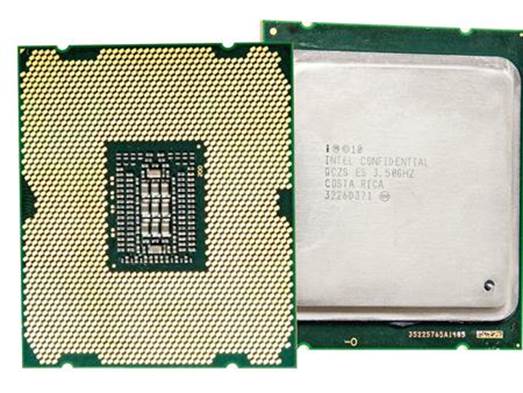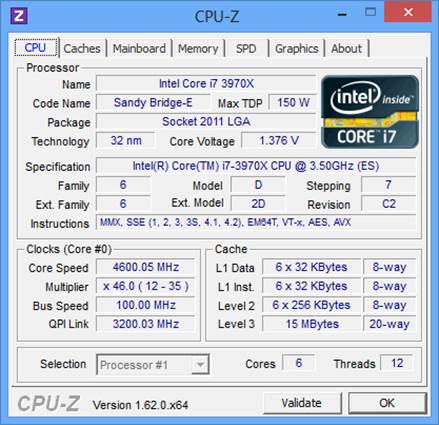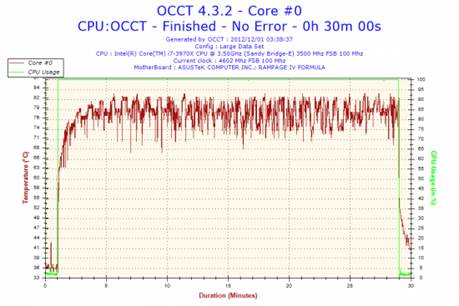There is an idea that increasing nominal clock
frequency of the new microprocessor will create a higher overclocking ability.
It is often true, but everything is totally different with Core i7-3970X. As we
have already seen, this microprocessor has been created by “legally”
overclocking the previous CPU model and doesn’t have anything new in its
semiconductor core. It uses the same exact producing programs of the 23 nm core
as Core i7-3960X, and its clock speed increased together with the TDP. In other
words, Core i7-3970X should overclock in exactly the same way as Core i7-3960X.

There
is an idea that increasing nominal clock frequency of the new microprocessor
will create a higher overclocking ability. It is often true, but everything is
totally different with Core i7-3970X.
But in fact, this isn’t bad. Core i7-3960X
overclocked well, and the same is true for Core i7-3970X. Both these microprocessors
belong to Extreme Edition line, which means that they have unlocked clock
frequency coefficient, e.g., allow settings the clock frequency without
changing BCLK frequency. However, LGA 2011 platform allows adjusting the clock
generator frequency in the 100-125 MHz range without any system stability loss.
So, overclock generators have a lot of freedom to experiment. Still, it is not good
to change BCLK frequency during Core i7-3970X overclocking: it doesn’t provide
any additional performance increase, but simply offer a route to adjust CPU’s
clock. Therefore, we chose to overclock our test microprocessor by simply controls
clock frequency coefficient.
Therefore, the goal of our experiments is
to determine the frequency, at the level that Core i7-3970X has the ability to
continuously operate in 24/7 mode without losing stability. Therefore, we don’t
use any potentially dangerous voltage settings and work with NZXT Havik 140
air-cooler. After that we tested our overclocked system stability by running
OCCT 4.3.2 app (test for 30 minutes in Large Data Set mode).
Our Core i7-3970X still remains stable at
the max frequency of 4.6 GHz. CPU Vcore in this case is set at 1.375 V and
Load-Line Calibration function is enabled.

Core
i7-3970X still remains stable at the max frequency of 4.6 GHz.
I have to say that max acceptable
temperature for Core i7-3970X cores is still the same as before - 91°C. Over
that level, the microprocessor’s temperature has a part in bocking data. Therefore,
choosing a cooling system with proper efficiency is important and the use of
more efficient systems may actually improve the overclocking results. In our
specific case, the temperatures are always 5-10°C below the critical maximum level.

Acceptable
max temperature for Core i7-3970X is 91°C
All earned results shows that Core i7-3970X
overclocks the same way as its predecessor. We have already reached 4.6 GHz
frequency before - this is typical overclocking level for any Sandy Bridge-E microprocessors
with C2 process under an efficient air-cooler. In other words, the new Intel micromicroprocessor
doesn’t really offer anything new to overclocking in this respect.
Conclusion
I have to admit that the new Intel Core
i7-3970X Extreme Edition microprocessor is pretty boring. And there are two
reasons. First, there is nothing essentially new about it. All we have is
simply a previously overclocked model from the manyfacturers. It creates some
performance increase of 2-4%, slightly increase in power consumption and no
real improvement in the overclocking ability. Second, the flagship LGA 2011 micromicroprocessors
do not have any real competitors. In case of heavy multi-threaded load, these
six-core monsters leave all LGA 1155 as well as Socket AM3+ microprocessors
very far behind.
However, no one promises anything miracle
here. The launch of Core i7-3970X Extreme Edition is more than an image move.
Intel simply reminds us of the LGA 2011 platform and the fact that fastest
desktop configurations are available. Of course, the existing of LGA 2011 users
will not rush to run after the new CPU, because it won’t recommend them
anything new. However, it may attract those who are in the process of building
a high-performance desktop in order to perform professional tasks requires
resources, those who haven’t enjoyed the LGA 2011 environment- friendly system.
If you are not those users, we have great news: Core i7-3970X has an average
price of 1,000 USD for Intel’s top micromicroprocessors, so it makes absolutely
no sense when considering Core i7-3960X at this point.
At the same time, the release of the new
Core i7-3970X also gives us concern. This CPU still uses the old 32 nm Sandy
Bridge-E design, while the low technology and mainstream users have used the more
energy-efficient 22 nm semiconductor devicesand the new Ivy Bridge
microarchitecture. As we see, Intel doesn’t rush to share their innovations
with the leading platform. The recent launch of Core i7-3970X indicates that it
still takes a while before we can take a look at new high-end six-core Ivy
Bridge-E LGA 2011 microprocessors.
|
Technical
specs
·
Number
of microprocessors: i7-3970X
·
Number
of cores: 6
·
Number
of lanes: 12
·
Clock
speed: 3.5 GHz
·
Max
Turbo frequency: 4 GHz
·
Intel®
Smart Cache: 15 MB
·
Lane/core
rate 35; DMI: 5 GT/s
·
Setting
instruction: 64-bit
·
Expanded
setting instruction: SSE4.2, AVX
·
Embedded
Options Available: no
·
Lithography:
32 nm
·
Max
TDP: 150 W
·
VID
voltage range: 0.6V-1.35V
·
Maximum sorage capacity (depends on the memory
type): 64 GB
·
Memory type: DDR3-1066/1333/1600
·
Numer of memory channels: 4
·
Max memory bandwidth: 51.2 GB/s
·
ECC
memory support: no
·
Integrated
graphic: no
·
Expanded
option: PCI Express Revision: 2.0; number of PCI Express lines: 40
·
Max
CPU configuration: 1
·
TCASE:
66.8°C
·
Size:
52.5mm x 45.0mm
·
Sock support: FCLGA2011
|